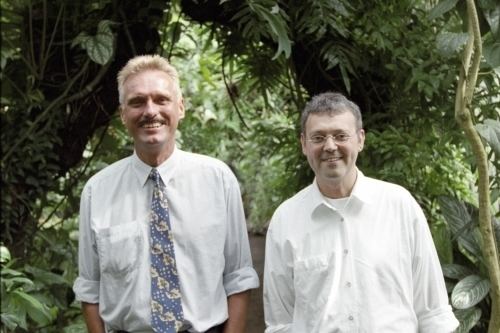Name Wilhelm Barthlott | ||
 | ||
Books Orchid Seed Diversity: A Scanning Electron Microscopy Survey | ||
Prof dr wilhelm barthlott umweltpreistr ger 1999
Wilhelm Barthlott (born 1946 in Forst, Germany) is a German botanist and bionics/biomimetics expert. His official botanical author citation is “Barthlott”.
Contents
- Prof dr wilhelm barthlott umweltpreistr ger 1999
- Prof dr wilhelm barthlott 99 seconds for the future of biodiversity
- Career
- Biodiversity research classification and biogeography of plants
- Bionics Biomimetics and Biological Interfaces
- Honors and awards
- Publications
- Selected works
- Supporting Documentation
- References

Barthlott’s areas of specialization are research in biodiversity (Global distribution, assessment, and change in biodiversity) and Bionics/Biomimetics (biological surfaces and their biomimetic technical applications).

He is one of the pioneers in the field of biological and technical interfaces. Based on his systematic research on plant surfaces, he developed self-cleaning (Lotus Effect®) technical surfaces and technical surfaces which permanently retain air under water (Salvinia® Effect). This led to a paradigm shift in particular areas of materials science and facilitated the development of superhydrophobic biomimetic surfaces. His map of the global biodiversity distribution is the foundation for numerous research topics. Barthlott has been honored with various awards and prizes, e. g. the German Environment Award (Deutscher Umweltpreis).

Prof dr wilhelm barthlott 99 seconds for the future of biodiversity
Career

Wilhelm Barthlott studied biology, physics, chemistry, and geography at the University of Heidelberg, Germany. He earned his doctorate in 1973 with a dissertation subject based on systematics and biogeography of epiphytic cacti investigated via the scanning electron method. He was appointed a professorship at the Free University of Berlin (Freie Universität Berlin) at the Institute for Systematic Botany and Plant Geography from 1982 to 1985. In 1985 he became the chair of systematic botany at the Botanical Institute and also director of the Botanical Gardens of the University of Bonn In 2003 he established the Nees Institute for Biodiversity of Plants as founding director. He was influential in the reorganization and expansion of both institutions.
Barthlott became emeritus in 2011, and continued as the head of a long-run research project “Biodiversität im Wandel” (“Biodiversity in Change”) until 2015, of the Academy of Sciences and Literature of Mainz. He co-founded with Walter Erdelen (UNESCO) the Biodiversity Network in Bonn BION in 2011, which was implemented by Wilhelm Barthlott and his successor Maximilian Weigend in 2013. He is investigating biological and technical superhydrophobic interface within the scope of his research projects (e.g. the BMBF joint research project ARES).
Biodiversity research, classification and biogeography of plants
Barthlott has done extensive research focusing on Andean South America and Africa, in particular on the taxonomy and morphology of Neotropical cacti, orchids and bromeliads, applying scanning electron microscopy and molecular methods. Barthlott’s studies on carnivorous plants converged systematic and ecological research. These studies led to the discovery of the first protozoan trapping plant, Genlisea. This genus also exhibits one of the highest evolutionary rates and has the smallest known genome among all flowering plants. The naming of Genlisea barthlottii pays tribute to his investigation regarding this topic. The monotypical genus Barthlottia madagascariensis and ten further species were named after him. A complete list of plants named by him can be found on the IPNI.
His biogeographic-ecological work was mostly conducted in South America, West Africa and Madagascar. His work concentrated on the dessert regions, epiphytes in tropical forest canopy, as well as tropical inselbergs. Additional works concentrate on the global mapping of biodiversity and its macroecological causal dependencies on the climate and other abiotic factors (Geodiversity), including migration and globalization. His Biodiversity Distribution Map has been published in numerous textbooks in addition to being the foundation for many postgraduate studies. In the framework of the BMBF-BIOTA-AFRICA project led by him, biodiversity patterns in Africa as a model continent are analyzed and potential impacts of climate change are investigated.
Bionics, Biomimetics, and Biological Interfaces
Wilhelm Barthlott was the first botanist to use high resolution in scanning electron microscopy systematically in the research of biological surfaces since 1970. Most prominent among his results was the discovery of the self-cleaning effect of superhydrophobic micro- and nanostructured surfaces, which were technically realized with the trademark Lotus Effect® from 1998 on. Resulting products are distributed worldwide. The patents and the trademark Lotus Effect® are owned by the company Sto-AG.
Currently, research on biological interfaces and bionics is Barthlott’s area of central interest. (Barthlott Mail Neinhuis and Barthlott Rafiqpoor Erdelen) Ongoing research areas include air-retaining surfaces on the model of the floating fern Salvinia, which is based on a complex physical principle (Salvinia® Effect). Technical application of this effect is conceivable in shipping: By means of a reduction in frictional resistance, a 10% decrease in fuel consumption could potentially be achieved.
Honors and awards
Publications
Wilhelm Barthlott’s Publications include more than 440 titles, among them are numerous books. A complete directory can be found at Wilhelm Barthlott Google Scholar Citations or www.lotus-salvinia.de
Selected works
Barthlott, W., Mail, M., Bhushan, B. & K. Koch (2017), Plant Surfaces: Structures and Functions for Biomimetic Innovations. – Nano-Micro Letters,9:23, Springer http://rdcu.be/ohK3
Barthlott, W., Rafiqpoor, M.D. & W.R. Erdelen, (2016) Bionics and Biodiversity – Bio-inspired Technical Innovation for a Sustainable Future. – in: “Biomimetic Research for Architecture: Biologically-Inspired Systems ”, pp. 11–55, (Eds.: J. Knippers et al.), Springer Publishers. DOI: 10.1007/978-3-319-46374-2
Barthlott, W. & Rafiqpoor, M.D. (2016): Biodiversität im Wandel – Globale Muster der Artenvielfalt. In: Lozán et al. (Edts): Warnsignal Klima: Die Biodiversität, pp. 44–50. In Wissenschaftliche Auswertungen/GEO [Download PDF]
Barthlott, W., Obholzer, J., Rafiqpoor, M.D., (2016) Pflanzen der Heiligen Bücher Bibel und Koran - النباتات في الكتب السماوية: الإنجيل و القرآن. BfN Skripten No. 448, 106 S.,[Download PDF]
Barthlott, W., Mail, M. & C. Neinhuis, (2016) Superhydrophobic hierarchically structured surfaces in biology: evolution, structural principles and biomimetic applications.- Phil. Trans. R. Soc. A. DOI:10.1098/rsta.2016.0191
Barthlott, W. et al. (2015): Biogeography and Biodiversity of Cacti. - Schumannia 7, pp. 1–205, ISSN 1437-2517 [Download Flyer]
Barthlott, W. et al. (2014): Orchid seed diversity: A scanning electron microscopy survey. – Englera 32, pp. 1–244.[Download PDF]
Yan, Y. Y., Gao, N. & W. Barthlott (2011): Mimicking natural superhydrophobic surfaces and grasping the wetting process: A review on superhydrophobic surfaces. pp. 80–105. Adv.Colloid Interface Science, DOI: 10.1016/j.cis.2011.08.005
Cerman, Z., Barthlott, W. & J. Nieder (2011): Erfindungen der Natur: Bionik – Was wir von Pflanzen und Tieren lernen können. 3rd edn, 280 pp, Rowohlt,
Sommer, J. H., Kreft, H., Kier, G., Jetz, W. Mutke, J. & W. Barthlott (2010): Projected impacts of climate change on regional capacities for global plant species richness. Proc. Royal Soc. DOI: 10.1098/rspb.2010.0120
Kier, G., Kreft, H., Lee, T. M., Jetz, W., Ibisch, P., Nowicki, C., Mutke, J. & W. Barthlott (2009): A global assessment of endemism and species richness across island and mainland regions. PNAS 106 (23):DOI: 10.1073/pnas.0810306106
Barthlott, W. et al. (2009): A torch in the rainforest: thermogenesis of the Titan arum (Amorphophallus titanum). Plant Biol. 11 (4): 499-505 DOI: 10.1111/j.1438-8677.2008.00147.x
Barthlott, W.et al. (2007): The curious world of carnivorous plants. 244 pp.,Timber Press
Greilhuber, J.,Borsch,T., Müller, K., Worberg, A., Porembski, S. & W. Barthlott (2006): Smallest angiosperm genomes found in Lentibulariaceae, with chromosomes of bacterial size. Plant Biol. 8: 770-777 DOI:10.1055/s-2006-924101
Barthlott, W. et al. (2005): Global centres of vascular plant diversity. Nova Acta Leopoldina 92 (342): 61-83
Borsch, T., Hilu, K. W., Quandt, D. Wilde, V., Neinhuis, C. & W. Barthlott (2003): Noncoding plastid trnT-trnF sequences reveal a well resolved phylogeny of basal angiosperms. J. Evol. Biol. 16: 1-19 DOI: 10.1046/j.1420-9101.2003.00577.x
Barthlott, W. & M. Winiger (eds.) (2001): Biodiversity. A challenge for development research and policy. 429 pp., Springer Publishers DOI:10.1007/978-3-662-06071-1
Porembski, S. & W. Barthlott (eds.) (2000): Inselbergs: biotic diversity of isolated rock outcrops in tropical and temperate regions. 528 pp., Springer Publishers DOI:10.1007/978-3-642-59773-2
Barthlott, W. et al. (1998): First protozoa-trapping plant found. Nature 392: 447 DOI: 10.1038/33037
Barthlott, W. & C. Neinhuis (1997): Purity of the sacred lotus, or escape from contamination in biological surfaces. Planta 202: 1-8 DOI: 10.1007/s004250050096
Barthlott, W., Lauer, W. & A. Placke (1996): Global distribution of species diversity in vascular plants: towards a world map of phytodiversity. Erdkunde 50: 317-327 DOI: 10.1007/s004250050096
Wagner, T., Neinhuis, C. & W. Barthlott (1996): Wettability and contaminability of insect wings as a function of their surface sculptures. Acta Zoologica 77 (3): 213-225 DOI: 10.1111/j.1463-6395.1996.tb01265.x
Burr, B., Rosen, D. & W. Barthlott (1995): Untersuchungen zur Ultraviolettreflexion von Angiospermenblüten. III. Dilleniidae und Asteridae. 186 pp , Akad. Wiss. Lit. Mainz. F. Steiner Verlag, Stuttgart,.[Download PDF]
Noga, G., Wolter, M., Barthlott, W. & W. Petry (1991): Quantitative evaluation of epicuticular wax alterations as induced by surfactant treatment. Angew. Bot. 65: 239-252
Barthlott, W. & E. Wollenweber (1981): Zur Feinstruktur, Chemie und taxonomischen Signifikanz epicuticularer Wachse und ähnlicher Sekrete. 67 S., Akad. Wiss. Lit. Mainz. F. Steiner Verlag, Stuttgart,[Download PDF]
Barthlott, W. (1979): Cacti. 249 S., Stanley Thornes Publishers, London
Barthlott, W. & N. Ehler (1977): Raster-Elektronenmikroskopie der Epidermis-Oberflächen von Spermatophyten. 105 pp ., Akad. Wiss. Lit. Mainz. F. Steiner Verlag, Stuttgart,[Download PDF]
